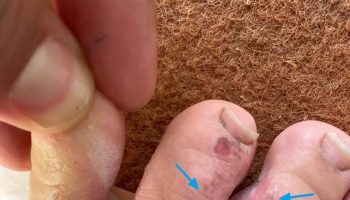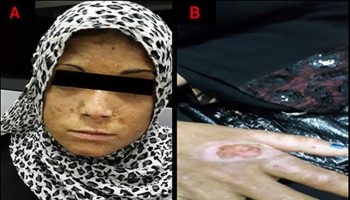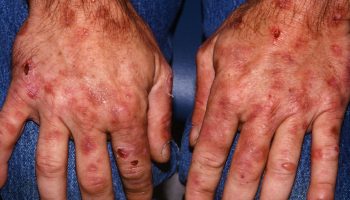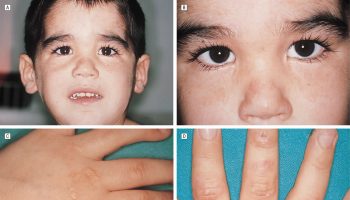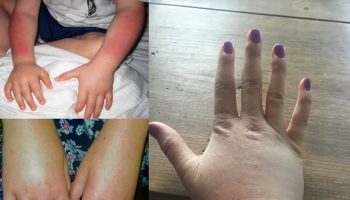Felty syndrome
Felty syndrome is a rare extra-articular manifestation of rheumatoid arthritis, usually affects patients with long-standing rheumatoid arthritis disease 1. The triad of neutropenia (abnormally low concentration of neutrophils, a type of white blood cell), splenomegaly (a swollen spleen) and rheumatoid arthritis is characteristic of Felty syndrome 2. Felty syndrome is reported in less than one percent of patients with rheumatoid arthritis 3. Patients with Felty syndrome typically present with neutropenia, splenomegaly, in addition to erosive rheumatoid arthritis 3. People with Felty syndrome are at risk for infection because they have a low white blood cell count. The diagnosis of Felty syndrome as the first manifestation of rheumatoid arthritis is exceedingly uncommon 3. The development of unexplained neutropenia in healthy patients should prompt the work up for Felty syndrome, especially in patients with suggestive demographics, signs, and symptoms. Differentiation between large granular lymphocyte leukemia and Felty syndrome is necessary as both can present with neutropenia, and are associated with rheumatoid arthritis 1.
In most cases, people who have Felty syndrome are not getting full treatment for rheumatoid arthritis. They may need other medicines to suppress their immune system and reduce the activity of their rheumatoid arthritis. Immunosuppressive therapy has improved the prognosis of patients with Felty syndrome given the decreasing rates of splenectomies done in those patients over the last decades.
Methotrexate may improve the low white blood cell count.
Granulocyte-colony stimulating factor (G-CSF) may raise the neutrophil count.
Some people benefit from removal of the spleen (splenectomy).
Hospital admission is mandatory for patients with serious life-threatening infections; cultures and parenteral antibiotics are indicated in such situations. It is important to acknowledge the possibility of infection with encapsulated organisms because splenomegaly may be a marker for a dysfunctional reticuloendothelial system incapable of clearing these organisms. Staphylococcus aureus, streptococcal species, and gram-negative rods are potential infecting organisms.
Consult the following specialists as needed:
- Rheumatologist
- Hematologist
- Infectious diseases specialist
Felty syndrome causes
The cause of Felty syndrome is unknown. Felty syndrome is more common in people who have had rheumatoid arthritis for a long time.
Risk factors for Felty syndrome include the following:
- Rheumatoid factor positivity in high titers
- Long-standing disease
- Aggressive and erosive synovitis – Patient with Felty syndrome may present with mild rheumatoid arthritis, but Felty syndrome is clearly associated with severe disease and extra-articular manifestations
- Human leukocyte antigen (HLA)-DR4 positivity and DR4 homozygosity – This may be due to the presence of HLA-DR4 in patients who have severe disease
- Extra-articular rheumatoid arthritis manifestations
Felty syndrome symptoms
Felty syndrome symptoms include:
- General feeling of discomfort (malaise)
- Fatigue
- Loss of appetite
- Unintentional weight loss
- Pale-looking skin
- Joint swelling, stiffness, pain, and deformity
- Recurrent infections
- Eye burning or discharge
Physical findings in Felty syndrome include the following:
- Splenomegaly, possibly nonpalpable
- Hepatomegaly, usually mild
- Lymphadenopathy
- Weight loss
- Rheumatoid nodules
- Sjögren syndrome
- Articular findings of long-standing rheumatoid arthritis – Joint deformities typical of rheumatoid arthritis, as well as synovitis (joint swelling and tenderness), which may be mild at presentation
- Small-vessel inflammation (vasculitis) – Lower-extremity ulcers, palpable purpura and brownish pigmentary changes of the lower extremities, and periungual infarcts
- Signs of systemic vasculitis – Mononeuritis multiplex and extremity ischemia
- Other findings – Pleuritis, peripheral neuropathy, episcleritis, and signs of portal hypertension
Many years of aggressive destructive rheumatoid arthritis precede the onset of Felty syndrome. On occasion, rheumatoid arthritis and Felty syndrome develop simultaneously 4. The extra-articular manifestations of rheumatoid arthritis (eg, rheumatoid nodules, pleuropericarditis, vasculitis, peripheral neuropathy, episcleritis, other forms of eye involvement, Sjögren syndrome, adenopathy, skin ulcers) are more common in those patients who develop Felty syndrome.
Patients with Felty syndrome often report symptoms of mild inflammatory joint disease caused by synovitis; it is often the case that their burden of synovitis is less than that experienced previously. The history usually reveals a long preceding period of active and aggressive joint disease, which can be confirmed by means of physical examination and plain radiography. Some patients present with quiescent or so-called “burned-out” joint disease. A lack of synovitis or active joint disease should not dissuade the clinician from considering the diagnosis of Felty syndrome in an rheumatoid arthritis patient.
Patients with Felty syndrome commonly present with bacterial infections of the skin and respiratory tract. An aggressive level of immunosuppression directed at the underlying rheumatoid arthritis may contribute to this susceptibility to infection.
Patients may present with left upper quadrant pain, initiated by splenic infarcts or capsular distension of the spleen.
Felty syndrome complications
Complications of Felty syndrome include the following:
- Splenic rupture
- Life-threatening infection
- Toxicity due to immunosuppressive regimens
- Portal hypertension and gastrointestinal bleeding due to nodular regenerative hyperplasia of the liver
Felty syndrome diagnosis
A physical exam will show:
- Swollen spleen
- Joints that show signs of rheumatoid arthritis
- Possibly swollen liver and lymph nodes
A complete blood count (CBC) white blood cell (WBC) count and differential may show a low number of white blood cells called neutrophils. Studies show that the greatest risk for infection is a granulocyte count lower than 1000/µL. It must be kept in mind, however, that the level of neutropenia varies over time without medical intervention. Granulocyte dysfunction and an absolute decrease in the number of granulocytes may predispose to infection.
Anemia and thrombocytopenia may result from hypersplenism. Anemia of chronic disease may result from the underlying inflammatory disease.
Some 98% of patients with Felty syndrome have a positive test for rheumatoid factor. This is because extra-articular manifestations of rheumatoid arthritis are strongly associated with rheumatoid factor.
Antinuclear antibodies (ANAs), found in 67% of Felty syndrome cases; antihistone antibodies; and even antineutrophil cytoplasmic antibodies (perinuclear pattern; p-ANCA), found in 77% of cases, commonly occur in patients with Felty syndrome. The significance of autoantibodies in Felty syndrome is unknown, and their contribution, if any, to the disease itself is uncertain.
Erythrocyte sedimentation rate (ESR) and serum immunoglobulin levels are invariably elevated in patients with Felty syndrome. Cryoglobulins may be present.
An abdominal ultrasound may confirm a swollen spleen.
Bone marrow aspiration and biopsy are especially important to rule out large granular lymphocyte leukemia. The bone marrow of patients with Felty syndrome shows adequate megakaryocytes and myeloid hyperplasia with arrested development at the level of immature cell forms.
An unusual type of liver involvement known as nodular regenerative hyperplasia is associated with Felty syndrome. This condition is characterized by mild portal fibrosis or lymphocyte and plasma cell infiltration but is not typical of cirrhosis. It may be complicated by portal venule occlusion and regenerative nodule formation.
Felty syndrome treatment
The best way of treating Felty syndrome is to control the underlying rheumatoid arthritis. Immunosuppressive therapy for rheumatoid arthritis often improves granulocytopenia and splenomegaly; this finding reflects the immune-mediated nature of Felty syndrome. Most of the traditional medications used to treat rheumatoid arthritis have been used in the treatment of Felty syndrome. No well-conducted, randomized, controlled trials support the use of any single agent. Most reports on treatment regimens involve small numbers of patients.
Methotrexate acts faster than gold salts and is the agent preferred by rheumatologists for treating rheumatoid arthritis 5. Almost all patients with rheumatoid arthritis are treated with methotrexate currently. If urgent correction of neutropenia is unnecessary, most practicing rheumatologists use methotrexate first when treating Felty syndrome, usually in combination with folic acid to minimize adverse effects. The beneficial effects of methotrexate may not be evident until 4-8 weeks after the initiation of therapy.
Because of the potential for leukopenia, cyclophosphamide is of limited utility in this setting, although it may have a role in some cases. A small number of patients with refractory Felty syndrome have been reported to respond to high-dose cyclophosphamide 6; however, physicians have had far more experience using cyclophosphamide for rheumatoid vasculitis and other serious rheumatoid arthritis extra-articular manifestations than for Felty syndrome. For this reason, this agent is not a preferred initial choice for treatment of Felty syndrome.
Penicillamine is used infrequently in rheumatoid arthritis because of its adverse effect profile. It is never a first-choice therapy for patients with Felty syndrome.
Etanercept, adalimumab, and infliximab have all been prescribed for rheumatoid arthritis. These agents act by blocking the effects of tumor necrosis factor alpha (TNF-α). They are known to be very effective in the treatment and control of rheumatoid arthritis, though clinical experience with using them to treat Felty syndrome is comparatively limited 7. Consensus has built that they do not offer much in the treatment of Felty syndrome.
Intravenous (IV) immunoglobulin (IVIg) has not been demonstrably successful on a reproducible basis.
Recombinant granulopoietic growth factors, such as granulocyte colony-stimulating factor (G-CSF) and granulocyte-macrophage colony-stimulating factor (GM-CSF), effectively and quickly raise the granulocyte count, which is important in patients with life-threatening infections. Initial treatment of patients with Felty syndrome and life-threatening infections should include administration of a growth factor. Long-term use of G-CSF (granulocyte colony-stimulating factor) appears to be well tolerated, though hypersensitivity vasculitis and flareups of the underlying rheumatoid arthritis have been reported.
At high doses, corticosteroids can increase the granulocyte count, partly through demargination. This effect does not persist when the dose is tapered to a typical low dose (< 10 mg/day) used for rheumatoid arthritis articular disease. Empiric administration of high-dose IV methylprednisolone is often prescribed for Felty syndrome, but the effect is time-limited. Long-term use of high-dose corticosteroids further increases the risk of infection. Corticosteroids should probably be viewed as a second-line treatment modality.
Case reports from the 2000s noted a lack of response to leflunomide 8 and a response to salazosulfapyridine 9.
Initial reports on using rituximab to treat Felty syndrome were negative 10, but subsequent reports were more encouraging 11. Current data suggest that rituximab should be considered in refractory Felty syndrome 12. Rituximab is becoming a preferred biologic treatment choice, with a better response pattern than anti-TNF agents 13.
Surgical treatment (ie, splenectomy) may be warranted in certain cases. Granulocytopenia recurs in approximately 25% of patients who have undergone splenectomy.
Long-term monitoring
Patients with Felty syndrome should be scheduled for regular follow-up with a rheumatologist to monitor therapy and to assess progress.
No firm guidelines address immunization practice in Felty syndrome patients, but ensuring vaccination against encapsulated organisms seems prudent.
Recommended patient activity levels should be dictated by infection risk and spleen size. In general, patients should avoid any activity that could result in blunt trauma to the left upper quadrant.
Felty syndrome prognosis
Although many individuals with Felty syndrome are asymptomatic, others become symptomatic and may develop life-threatening infections. Pulmonary and skin infections are common. Mortality and morbidity are heavily influenced by the level of debilitation due to the underlying rheumatoid arthritis, along with the extent of immunosuppressive therapy used in treating both rheumatoid arthritis and Felty syndrome. One study from southwest England observed 32 patients with Felty syndrome; 5 patients died of overwhelming bronchopneumonia during a mean follow-up period of 5.2 years 14.
Curiously, over the past 20 years in the United States, the frequency of hospitalization for rheumatoid vasculitis and ultimate splenectomy in patients with Felty syndrome has dropped, possibly because earlier and more aggressive treatment of rheumatoid arthritis tends to control the disease before the manifestations of Felty syndrome appear.
Granulocytopenia is defined as an absolute neutrophil count lower than 2000/µL, and the infection risk increases as the ANC drops. Infection incidence increases significantly when the polymorphonuclear leukocyte count is lower than 1000/µL.
In a retrospective study of male patients with Felty syndrome treated at the Department of Veterans Affairs, lymphoproliferative malignancies were more prevalent; in particular, the patients had an increased prevalence of non-Hodgkin lymphoma 15.
- Nimri D, Abdallah MA, Waqas QA, Abdalla A, Tantoush H. Severe Neutropenia Complicated with Necrotizing Fasciitis Unveils a Diagnosis of Rheumatoid Arthritis: A Case Report. Cureus. 2019;11(2):e4079. Published 2019 Feb 15. doi:10.7759/cureus.4079[↩][↩]
- Felty syndrome. Goldberg J, Pinals RS. Seminars in Arthritis and Rheumatism Volume 10, Issue 1, August 1980, Pages 52-65 https://doi.org/10.1016/0049-0172(80)90014-1[↩]
- Neutropaenia and splenomegaly without arthritis: think rheumatoid arthritis. Aslam F, Cheema RS, Feinstein M, Chang-Miller A. BMJ Case Rep. 2018;2018[↩][↩][↩]
- Jain T, Mittal C, Sengupta R, Rubin B. Non-articular Felty’s syndrome: An uncommon diagnosis. Neth J Med. 2015 Nov. 73 (9):435-6.[↩]
- Felty Syndrome Treatment & Management. https://emedicine.medscape.com/article/329734-treatment[↩]
- Brücker R, Schlumpf U. [Felty syndrome: a therapy-resistant variant of chronic rheumatoid arthritis? 2 case reports and literature review]. Praxis (Bern 1994). 1996 Apr 16. 85(16):534-40.[↩]
- Ghavami A, Genevay S, Fulpius T, et al. Etanercept in treatment of Felty’s syndrome. Ann Rheum Dis. 2005 Jul. 64(7):1090-1.[↩]
- Talip F, Walker N, Khan W, et al. Treatment of Felty’s syndrome with leflunomide. J Rheumatol. 2001 Apr. 28(4):868-70.[↩]
- Ishikawa K, Tsukada Y, Tamura S, et al. Salazosulfapyridine-induced remission of Felty’s syndrome along with significant reduction in neutrophil-bound immunoglobulin G. J Rheumatol. 2003 Feb. 30(2):404-6.[↩]
- Sordet C, Gottenberg JE, Hellmich B, et al. Lack of efficacy of rituximab in Felty’s syndrome. Ann Rheum Dis. 2005 Feb. 64(2):332-3.[↩]
- Tomi AL, Lioté F, Ea HK. One case of Felty’s syndrome efficiently treated with rituximab. Joint Bone Spine. 2012 Mar 6.[↩]
- Narváez J, Domingo-Domenech E, Gómez-Vaquero C, López-Vives L, Estrada P, Aparicio M, et al. Biological agents in the management of Felty’s syndrome: a systematic review. Semin Arthritis Rheum. 2012 Apr. 41(5):658-68.[↩]
- Sarp U, Ataman S. A benefiicial long-term and consistent response to rituximab in the treatment of refractory neutropenia and arthritis in a patient with Felty syndrome. J Clin Rheumatol. October, 2014. 207:398.[↩]
- Campion G, Maddison PJ, Goulding N, James I, Ahern MJ, Watt I, et al. The Felty syndrome: a case-matched study of clinical manifestations and outcome, serologic features, and immunogenetic associations. Medicine (Baltimore). 1990 Mar. 69(2):69-80.[↩]
- Gridley G, Klippel JH, Hoover RN, et al. Incidence of cancer among men with the Felty syndrome. Ann Intern Med. 1994 Jan 1. 120(1):35-9.[↩]

